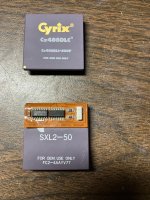Ok, so 35 years ago the Sun386i was pretty much abandoned as a platform. Which is not totally fair, it's actually a nice little system with an impressive framebuffer, network, all the bells and whistles. It's biggest problem is the CPU is just dog slow. It has no on board cache, clocks at 25mhz and is just plain terrible.
While they never released a 486 version several companies (Cyrix, TI, and of course the IBM Blue Lightning) released chips that had accelerated 386 capabilities. 1k cache up to 8k, better execution engine and pin compatible.
A Long time ago I had a 386/25 accelerator chip with some logic on it that should have speeded the system up. Never worked, but I'll bet I still have it.
Last week I bought a Cyrix Cx486DLC-40GP processor which is a PGA132 pin compatible 386 replacement. 5 volt supply the whole nine yards. Dug out my 386i, fired it up and watched the LEDs flash on the back as it ran POST, shut down, popped in the Cyrix chip and....
Nothing. All LEDs on which means that whatever is happening the BOOT Rom is not getting to the point to turn on or off any LEDs.
So the question is: WHY?
Well let's think. First the chip is set to clock at 40mhz, so running it at 25mhz should be a simple slam dunk.
Second it does not have floating point instructions but can use the 80387 coprocessor. Since we're leaving that in the system that's not the problem.
There is the 1k cache, but why would that trash the 386i's boot? It's possible it interferes with the 82357 chip on the memory boards, not sure how that communicates with a 386 chip but plenty of 386 boards had off chip cache.
So hm.... I guess the first possibility is to see what's in the rom between first instruction and "toggle a LED" light. Any other thoughts?
While they never released a 486 version several companies (Cyrix, TI, and of course the IBM Blue Lightning) released chips that had accelerated 386 capabilities. 1k cache up to 8k, better execution engine and pin compatible.
A Long time ago I had a 386/25 accelerator chip with some logic on it that should have speeded the system up. Never worked, but I'll bet I still have it.
Last week I bought a Cyrix Cx486DLC-40GP processor which is a PGA132 pin compatible 386 replacement. 5 volt supply the whole nine yards. Dug out my 386i, fired it up and watched the LEDs flash on the back as it ran POST, shut down, popped in the Cyrix chip and....
Nothing. All LEDs on which means that whatever is happening the BOOT Rom is not getting to the point to turn on or off any LEDs.
So the question is: WHY?
Well let's think. First the chip is set to clock at 40mhz, so running it at 25mhz should be a simple slam dunk.
Second it does not have floating point instructions but can use the 80387 coprocessor. Since we're leaving that in the system that's not the problem.
There is the 1k cache, but why would that trash the 386i's boot? It's possible it interferes with the 82357 chip on the memory boards, not sure how that communicates with a 386 chip but plenty of 386 boards had off chip cache.
So hm.... I guess the first possibility is to see what's in the rom between first instruction and "toggle a LED" light. Any other thoughts?

